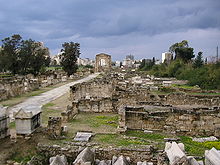Tyre Necropolis
 The al-Bass archaeological site | |
| Location | Tyre, Lebanon |
|---|---|
| Coordinates | 33°16′20″N 35°12′35″E / 33.27222°N 35.20972°E |
| Site notes | |
| Excavation dates | 1997-2008 |
The Al-Bass Tyre necropolis is a Lebanese UNESCO World Heritage site in the city of Tyre situated next to the el-Buss refugee camp. The necropolis, constituting the principal entrance of the town in antique times, is to be found on either side of a wide Roman and Byzantine avenue dominated by a triumphal arch of the 2nd century. Other important monumental vestiges of this archaeological area are an aqueduct, which carried water to the city, and a 2nd-century hippodrome.
The Roman and Byzantine necropolis

Discovered in 1962, the necropolis consists of hundreds of stone and marble sarcophagi from the Roman and Byzantine eras.[1] Several of them have Greek inscriptions or the names of those buried there, or their trade such as "wealthy purple dye manufacturer."[2] Others whose sides and covers are decorated with frescoes and bas-reliefs of works from Homer and others.
The Triumphal Arch is one of the most impressive relics of the site. Fallen apart but reconstructed in modern times, it dominates the well preserved Roman avenue which has a necropolis on either side scattered with hundreds of ornate stones and sculptured marble sarcophagi dating from the 2nd through the 6th century C.E.[3]
The Phoenician necropolis
In the northern section of the site there is a Phoenician necropolis of the ninth century B.C.E. formed by dug graves containing urns.[4]
Conservation of the site
Hostilities during 2006 threatened the site when a nearby building was bombarded. A post-conflict analysis by conservation experts found that many of the frescoes had sustained damage. This, combined with the significant lack of maintenance at the site, represents significant threats to the site.[5]
The site was already plundered in the 1990s. Find disappeared in the illegal antiquities market and some obelisks are now displayed at Nabu museum in El-Heri [6]
References
- ^ "Tyre". Lebanon Voice Chat - Gallery Sour. Archived from the original on 2011-07-13. Retrieved October 19, 2016.
- ^ "Tyre Things to Do". VirtualTourist.com. Retrieved October 19, 2016.
- ^ "About the necropolis". Retrieved December 20, 2017.
- ^ Aubet, María Eugenia (2010). "The Phoenician Cemetery of Tyre". Near Eastern Archaeology. 73: 2–3.
- ^ Toubekis, Georgios (2010). ""Lebanon: Tyre (Sour)"". In Machat, Christoph; Petzet, Michael; Ziesemer, John (eds.). Heritage at Risk: ICOMOS World Report 2008-2010 on Monuments and Sites in Danger (PDF). Berlin: Hendrik Bäßler verlag. p. 118.
- ^ https://www.almodon.com/society/2019/4/27/%D8%AA%D8%AD%D9%82%D9%8A%D9%82-%D8%A7%D8%B3%D8%AA%D9%82%D8%B5%D8%A7%D8%A6%D9%8A-%D9%81%D9%8A-%D8%A7%D9%84%D8%A2%D8%AB%D8%A7%D8%B1-%D8%A7%D9%84%D9%85%D8%AA%D8%A7%D8%AD%D9%81-%D9%88%D8%A7%D9%84%D8%AA%D8%AC%D8%A7%D8%B1%D8%A9-%D9%88%D8%A7%D9%84%D9%86%D9%87%D8%A8-1%7C تحقيق استقصائي في الآثار: المتاحف والتجارة والنهب (1). (Investigation on antiquities, museum, trade and looting (1)). almodonline (27.4.2019).

